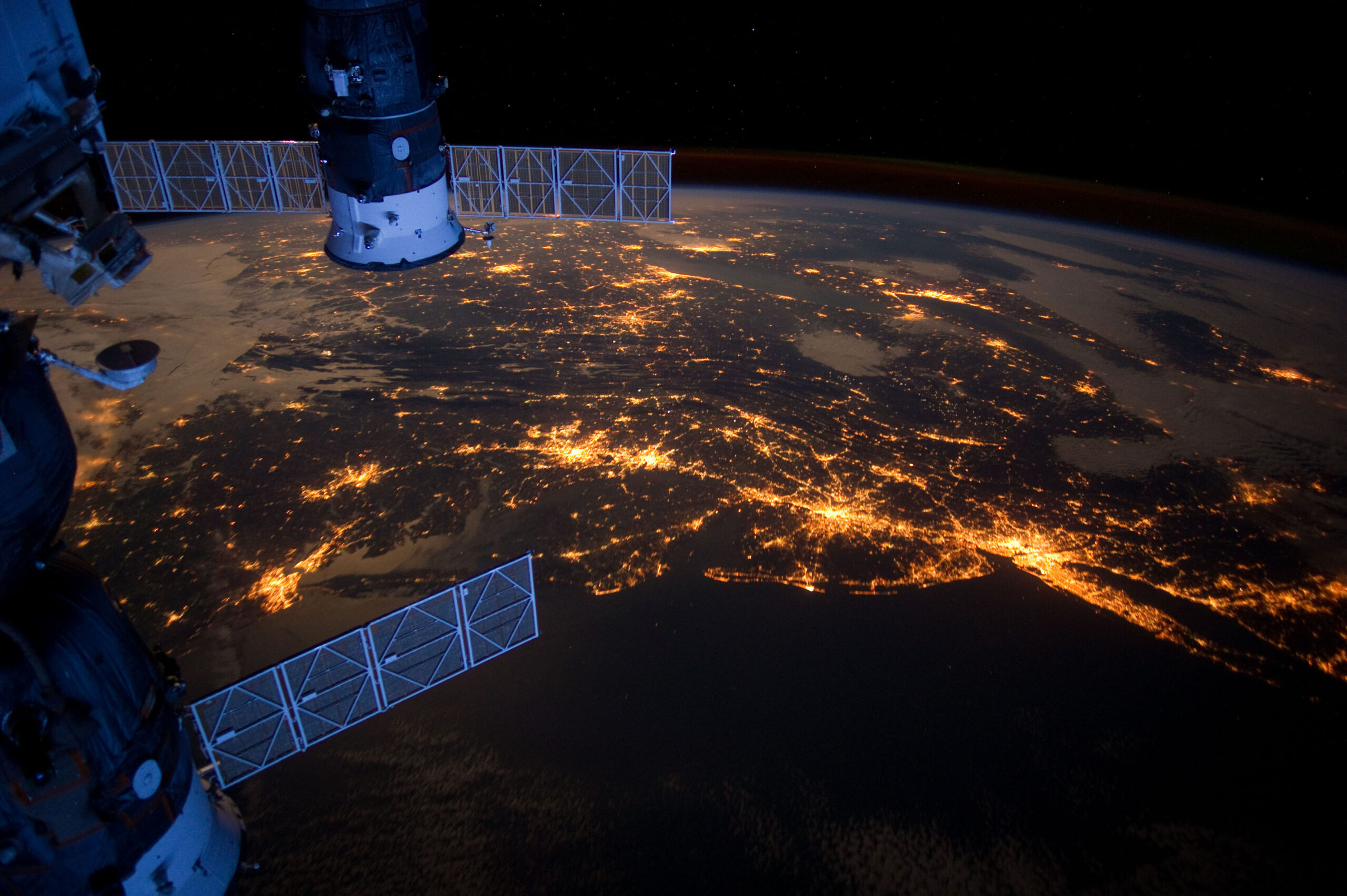July 29, 2025
The US neglects space disaster preparedness at its own peril
Space is “vastly, hugely, mind-bogglingly big,” science fiction author Douglas Adams once wrote. But these days, amid an intensifying competition for access to low Earth orbit (LEO), where most satellites operate, the vastness of space has begun to appear woefully small. As of last month, there were more than 12,700 active satellites in orbit. Of these, around 93 percent circle the Earth in LEO, including military and commercial constellations, such as SpaceX’s Starlink. That number is only expected to increase in the coming years.
Satellites control many of society’s most critical functions, including communications, navigation, and imaging for both civilian and military purposes. In recent decades, the United States has developed a commercial and strategic advantage through its presence in space, outpacing every other country in annual launches by at least eight to one. But this dominance also creates an Achilles’ heel. A “Day Zero” event, or a space-based disaster that degrades the operating environment in LEO, would disproportionately harm the United States compared to its nation-state rivals. While unlikely, this possibility is not as far-fetched as it may seem.
Filling up infinity: The problem of space debris
Far from the vast “final frontier” envisioned in science fiction, LEO now more closely resembles a busy urban airspace. Last year, SpaceX reported that its Starlink constellation of satellites made 275 maneuvers per day to avoid a growing number of space objects. The accidental collision in 2009 between US and Russian satellites illustrated the risks of this density. The crash generated thousands of pieces of debris, many too small to be tracked. One estimate suggests there are over one million objects between one and ten centimeters and more than 100 million particles smaller than one centimeter in LEO today. While many objects at lower orbits up to 500 kilometers above sea level fall back to Earth in less than twenty-five years, debris stuck at higher altitudes, between 700 and 1,200 kilometers high, can stay in orbit for centuries or more. And at the speed at which these objects travel, even the smallest fragment can cause catastrophic damage.
Researchers and Hollywood filmmakers have long speculated about a nightmare scenario in which a runaway chain of collisions destroys most objects in LEO and renders the region unusable. While the rapid-fire destruction depicted in the 2013 film Gravity is fictitious, the long-term danger it envisions is not. Three independent models—from NASA, the European Space Agency, and the Massachusetts Institute of Technology—forecast accelerated debris proliferation in LEO over the next few decades, even accounting for mitigation measures. This process, known as the “Kessler Syndrome,” would likely occur gradually, and it would impact some altitudes more seriously than others. But without immediate action, the scientific consensus suggests that a seriously degraded orbital environment is not a matter of if but when.
The global threat of asymmetric attacks
Intentional attacks are a concern as well. Adversaries could, for instance, see incentives to disrupt US space dominance by deploying anti-satellite (ASAT) weapons. Russia and China have both demonstrated extensive counterspace capabilities, including the ability to jam or spoof satellites near conflict zones. They have also tested so-called “direct ascent” ASAT weapons, essentially a missile launched from Earth to destroy a target in space. These debris-generating strikes vastly increase the risk of collateral damage and hasten the deterioration of LEO.
Even more concerningly, Russia launched a satellite into orbit in February 2022 that is purportedly designed to test the feasibility of a space-based nuclear weapon. A nuclear detonation in LEO would be catastrophic, producing a radiation belt that would linger in Earth’s magnetic field and fry the onboard electronics of unprotected satellites that passed through. A nuclear detonation could render LEO “unusable” for months or years, costing trillions of dollars in global damage. While all countries would suffer, the United States would be the most severely affected. And as the satellite disparity increases, the temptation to deny the United States an advantage by using an asymmetric strike against everyone’s satellites will only grow.
Both of these possibilities present real and sobering threats, but, as experts Clementine Starling-Daniels and Mark Massa have written, “A response is in order; hysteria is not.” The United States has numerous avenues to prevent or respond to even the worst-case scenarios in space. These measures fall into three broad categories: threat reduction, reconstitution, and redundancy.
Threat reduction
As the country with the most to lose from a space-based disaster, the United States has led the charge to protect access to space, including by spearheading the United Nations’ Outer Space Treaty. This treaty entered into force in 1967 and includes a ban on space-based nuclear weapons. More recently, the United States persuaded 155 nations to agree to a United Nations resolution banning direct-ascent ASAT missile tests. Now, US leaders should encourage other nations to uphold these commitments, as well as promote worldwide de-orbiting requirements for defunct satellites and coordinate space traffic management. This encouragement requires both leading by example and a comprehensive package of carrots and sticks for laggards.
Other options include shielding and hardening US satellites against various hazards. Innovations, such as the Whipple shield, can protect systems from debris up to one centimeter in diameter, and high-value satellites in LEO should be hardened against increased radiation similar to that which satellites in medium and geosynchronous orbits face. Radiation hardening of onboard electronics has recently become much more cost-effective and compact, but little is being done to implement these innovations, and even the military’s newest planned constellation, the Proliferated Warfighter Space Architecture, will reportedly be launched without such radiation shielding. Preventative action today may add cost and complexity, but it would provide critical US satellites with much greater protection against a deteriorated LEO environment.
Reconstitution
In cases where the disruption is short-lived, the United States should reconstitute its satellite fleets as quickly as possible to regain an advantage. The recent steep decline in launch costs is mostly due to economies of scale offered by SpaceX and competition from new players such as Blue Origin. Low launch costs based on mature and scalable technology will be essential to rebound from a disruption in LEO.
Additionally, diversifying launch sites would allow for quicker reconstitution of a reserve satellite fleet. Currently just two launch sites, Cape Canaveral in Florida and Vandenburg in California, host the majority of US launches, creating a major traffic jam. The US military and commercial operators should explore adding additional launch sites throughout the country, using the facilities of close US allies, and developing mobile launch platforms on land and sea. Adding more and more portable launch platforms would allow Washington to rapidly redeploy space assets, and it would frustrate adversaries’ efforts to deny the United States access to space by targeting its launch facilities during a conflict.
Redundancy
In situations where quick recovery is impossible, the United States should develop redundancies to current satellite systems. In a “Kessler Syndrome” event, LEO may become unviable for years. In this scenario, protecting access to critical communications systems such as undersea fiber-optic cables, as well as deploying terrestrial alternatives to satellites, will be essential. These “pseudolite” systems include eLORAN, visual positioning, and new innovations such as a novel technology that uses cosmic rays for navigation. None of these technologies can fully replace satellite functions, but a combination could provide a necessary backup in a satellite-denied environment. In this respect, however, the United States is already behind. Notably, China has built a robust ground-based network of fiber-optic and eLORAN systems to transmit accurate positioning and timing information if satellite signals are lost, giving Beijing an enormous strategic advantage in a hypothetical future conflict.
The possibility of a “Day Zero” in space should not be cause for alarm, but a call to action. The threat of debris or a space-based nuclear detonation can no longer be dismissed as a “black swan event.” Instead, responsible preparation for these threats will help prevent them. If an adversary knows that the United States possesses a resilient space industry and multiple redundant systems, that state may be less tempted to attack orbital assets in the first place. At the very least, US policymakers and the public must be willing to confront an uncomfortable question: In the event of a “Day Zero” in orbit, does the United States have a feasible alternative to space, and just how much is it prepared to lose?
William M. Reicher is a former young global professional with the ’s Scowcroft Center for Strategy and Security.
Fri, Jun 20, 2025
A guide to national security space trends in the GCC
Report
By
AzurX provides a comprehensive picture of the innovative strategies, ambitious missions, and inspiring visions propelling GCC nation space programs to new heights.
Image: Nighttime view from the International Space Station shows the Atlantic coast of the United States in this NASA handout image dated February 6, 2012. Metropolitan areas from the Virginia/Maryland/Washington, D.C. area are visible in the image that spans almost to Rhode Island. Boston is just out of frame at right. Long Island and the New York City area are visible in the lower right quadrant. Philadelphia and Pittsburgh are near the center. Parts of two Russian vehicles parked at the orbital outpost are seen in left foreground. Picture taken February 6, 2012. REUTERS/NASA










